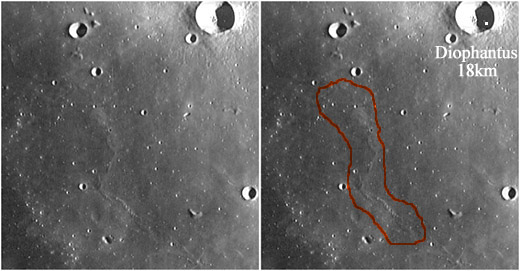Difference between revisions of "Dorsum Arduino"
(Created page with "<div id="content_view" class="wiki" style="display: block"> =Dorsum Arduino= {| class="wiki_table" | Lat: 24.9°N, Long: 35.8°W, Length: 107 km, Height: km, Rükl: 19<br /...") |
|||
| Line 10: | Line 10: | ||
[http://www.lpod.org/coppermine/thumbnails.php?album=search&type=full&search=Dorsum%20Arduino LPOD Photo Gallery] [http://www.lpi.usra.edu/resources/lunar_orbiter/bin/srch_nam.shtml?Dorsum%20Arduino%7C0 Lunar Orbiter Images] [http://www.lpi.usra.edu/resources/apollo/search/feature/?feature=Dorsum%20Arduino Apollo Images]<br /> <br /> - Apollo 15's orbital photography of '''Dorsum Arduino''':<br /> [http://www.lpi.usra.edu/resources/apollo/frame/?AS15-P-10294 AS15-P-10294] and stereo-companion [http://www.lpi.usra.edu/resources/apollo/frame/?AS15-P-10299 10299] (one doesn't have to scroll rightward because the dorsum is already visible near the photographic frame's upper margin).<br /> [http://www.lpi.usra.edu/resources/apollo/frame/?AS15-P-10296 AS15-P-10296] and stereo-companion [http://www.lpi.usra.edu/resources/apollo/frame/?AS15-P-10301 10301] (again, it's not necessary to scroll rightward, the dorsum is already visible near the photographic frame's lower margin).<br /> - Apollo 17's orbital photography of '''Dorsum Arduino''' during local sunrise:<br /> [http://www.lpi.usra.edu/resources/apollo/frame/?AS17-155-23741 AS17-155-23741] (looking northward, the largest one of the depicted craters is '''Diophantus D''').<br /> [http://www.lpi.usra.edu/resources/apollo/frame/?AS17-P-3124 AS17-P-3124], [http://www.lpi.usra.edu/resources/apollo/frame/?AS17-P-3125 3125], [http://www.lpi.usra.edu/resources/apollo/frame/?AS17-P-3126 3126] ('''Dorsum Arduino''' at right, beyond the central parts of all three frames).<br /> - Research Apollo 15 and Apollo 17 photography: Danny Caes<br /> <br /> | [http://www.lpod.org/coppermine/thumbnails.php?album=search&type=full&search=Dorsum%20Arduino LPOD Photo Gallery] [http://www.lpi.usra.edu/resources/lunar_orbiter/bin/srch_nam.shtml?Dorsum%20Arduino%7C0 Lunar Orbiter Images] [http://www.lpi.usra.edu/resources/apollo/search/feature/?feature=Dorsum%20Arduino Apollo Images]<br /> <br /> - Apollo 15's orbital photography of '''Dorsum Arduino''':<br /> [http://www.lpi.usra.edu/resources/apollo/frame/?AS15-P-10294 AS15-P-10294] and stereo-companion [http://www.lpi.usra.edu/resources/apollo/frame/?AS15-P-10299 10299] (one doesn't have to scroll rightward because the dorsum is already visible near the photographic frame's upper margin).<br /> [http://www.lpi.usra.edu/resources/apollo/frame/?AS15-P-10296 AS15-P-10296] and stereo-companion [http://www.lpi.usra.edu/resources/apollo/frame/?AS15-P-10301 10301] (again, it's not necessary to scroll rightward, the dorsum is already visible near the photographic frame's lower margin).<br /> - Apollo 17's orbital photography of '''Dorsum Arduino''' during local sunrise:<br /> [http://www.lpi.usra.edu/resources/apollo/frame/?AS17-155-23741 AS17-155-23741] (looking northward, the largest one of the depicted craters is '''Diophantus D''').<br /> [http://www.lpi.usra.edu/resources/apollo/frame/?AS17-P-3124 AS17-P-3124], [http://www.lpi.usra.edu/resources/apollo/frame/?AS17-P-3125 3125], [http://www.lpi.usra.edu/resources/apollo/frame/?AS17-P-3126 3126] ('''Dorsum Arduino''' at right, beyond the central parts of all three frames).<br /> - Research Apollo 15 and Apollo 17 photography: Danny Caes<br /> <br /> | ||
==Maps== | ==Maps== | ||
| − | ''([ | + | ''([[LAC%20zone|LAC zone]] 39B4)'' [http://www.lpi.usra.edu/resources/mapcatalog/LAC/lac39/ LAC map] [http://www.lpi.usra.edu/resources/mapcatalog/usgs/I465/ Geologic map] [http://www.lpi.usra.edu/resources/mapcatalog/LM/lm39/ LM map] [http://www.lpi.usra.edu/resources/mapcatalog/LTO/lto39b4_1/ LTO map]<br /> <br /> |
==Description== | ==Description== | ||
<br /> | <br /> | ||
Revision as of 15:46, 15 April 2018
Contents
Dorsum Arduino
| Lat: 24.9°N, Long: 35.8°W, Length: 107 km, Height: km, Rükl: 19 |
Table of Contents

IV-138-H3
Images
LPOD Photo Gallery Lunar Orbiter Images Apollo Images
- Apollo 15's orbital photography of Dorsum Arduino:
AS15-P-10294 and stereo-companion 10299 (one doesn't have to scroll rightward because the dorsum is already visible near the photographic frame's upper margin).
AS15-P-10296 and stereo-companion 10301 (again, it's not necessary to scroll rightward, the dorsum is already visible near the photographic frame's lower margin).
- Apollo 17's orbital photography of Dorsum Arduino during local sunrise:
AS17-155-23741 (looking northward, the largest one of the depicted craters is Diophantus D).
AS17-P-3124, 3125, 3126 (Dorsum Arduino at right, beyond the central parts of all three frames).
- Research Apollo 15 and Apollo 17 photography: Danny Caes
Maps
(LAC zone 39B4) LAC map Geologic map LM map LTO map
Description
Description: Wikipedia
Additional Information
A curious oblong cluster (or chain) of small depressions at the southern part of Dorsum Arduino (northeast of the rare bathtub/peanut-shaped crater Brayley G) is a noteworthy telescopic object! - DannyCaes DannyCaes Aug 27, 2011
Nomenclature
Giovanni Arduino (October 16, 1713 - March 21, 1795) was an Italian geologist, known as the father of Italian geology, who introduced the terms Primary, Secondary, Tertiary, and Quaternary in 1760 to classify four broad divisions of the Earth's rock surface, each earlier in deposition.
LPOD Articles
Bibliography
This page has been edited 1 times. The last modification was made by - tychocrater tychocrater on Jun 13, 2009 3:24 pm - afx3u2